Abstract
We previously reported that gamma delta T cells appeared and could play a protective role early in infections with intracellular bacteria such as Listeria monocytogenes, Mycobacterium bovis BCG, and Salmonella choleraesuis. To extend these findings to virus infection, we examined the developmental sequence of gamma delta T cells in bronchoalveolar lavage during the course of Sendai virus infection in C57BL/6 mice. To produce a natural but nonlethal infection course as far as possible, we used a sublethal dose of a wild-type virus which had not been subjected to serial passages in a chicken embryo, hence retaining full virulence for mice. Virus titers in lungs reached a peak on day 6 and then decreased to an undetectable level by day 10. This time course of virus reproduction was immediately and coincidentally followed by the developmental course of gamma delta T cells, in which the cell number peaked on day 7 and then decreased to a marginal level by day 10. On the other hand, the alpha beta T-cell number continued to increase until day 10 and remained at a high level thereafter. The early-appearing gamma delta T cells were CD4-, CD8-, IL-2R alpha- beta+, CD44+, Mel-14-, and LFA-1 alpha/beta+ in phenotype and used V gamma 1/2 and V gamma 4 and V delta 3, V delta 4, V delta 5, and V delta 6. The gamma delta T cells were responding to macrophages from infected mice when the cells were cultured in vitro. Furthermore, the expression of endogenous heat shock protein (hsp) was infection specific, and its level appeared to correlate with the gamma delta T-cell development. These results suggest that the early recruitment of gamma delta T cells, which proliferate in response to endogenous hsp+ cells, is also characteristic of this virus infection, although this view appears to be contradictory to earlier reports.
Full text
PDF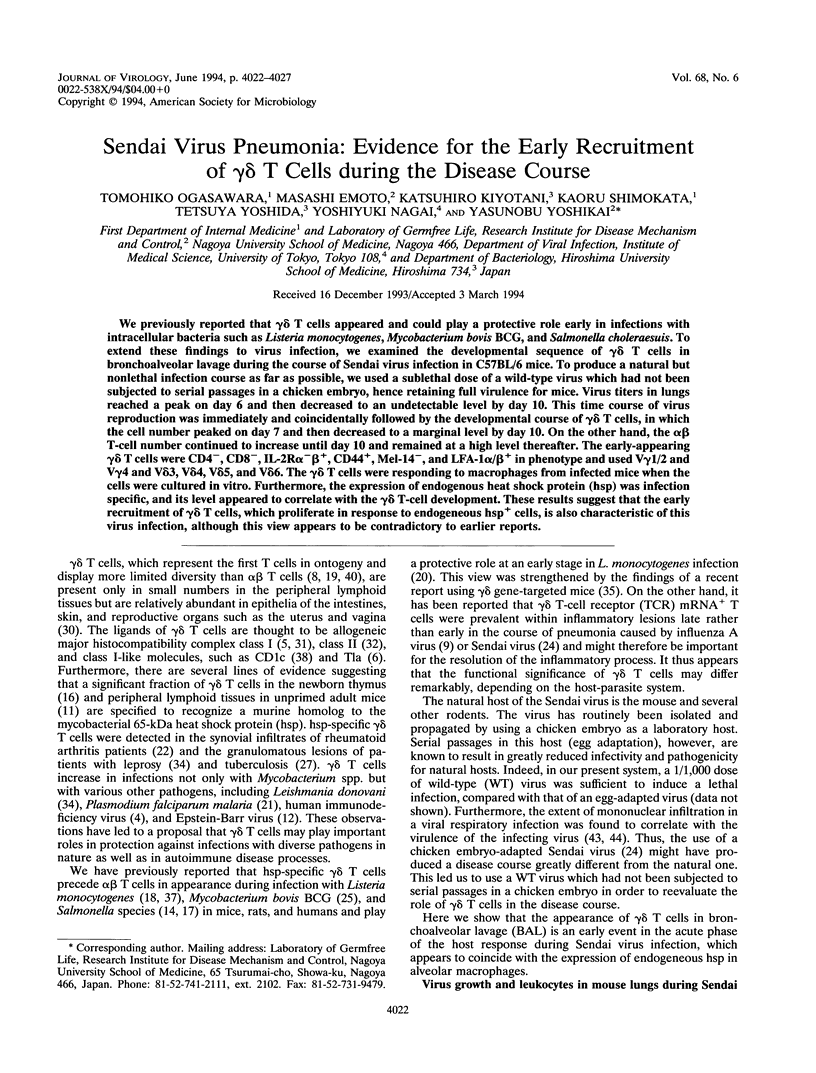
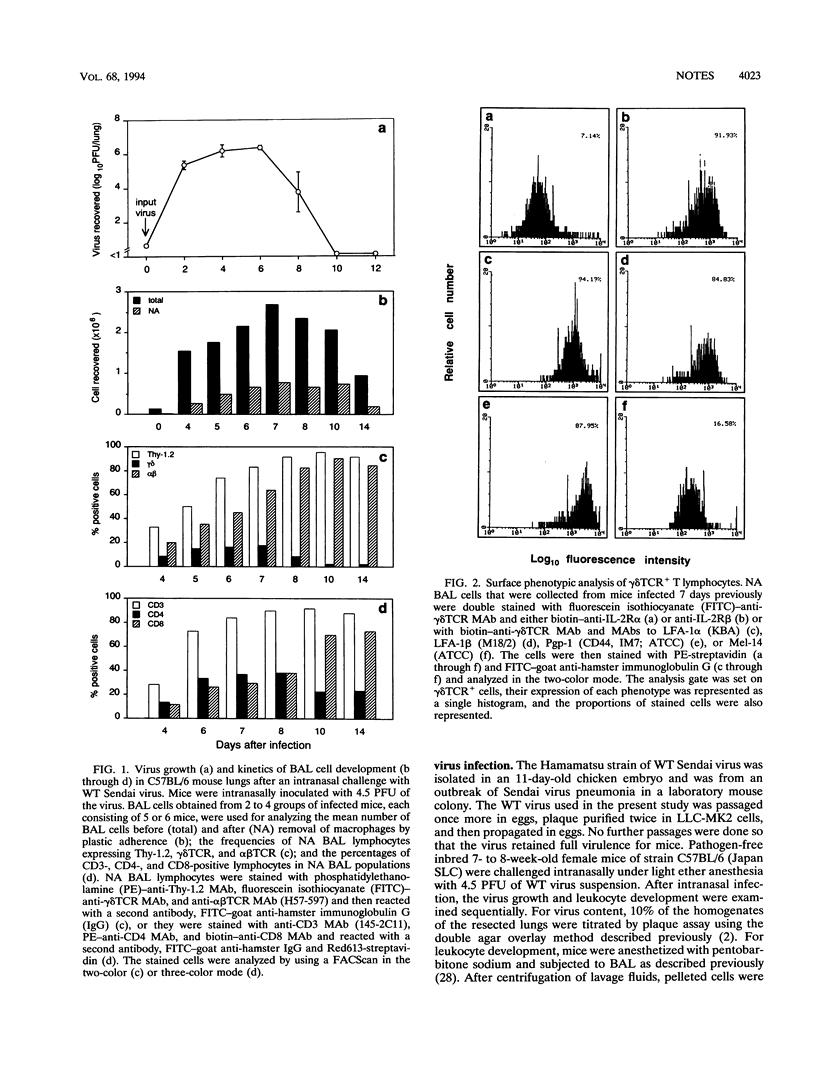
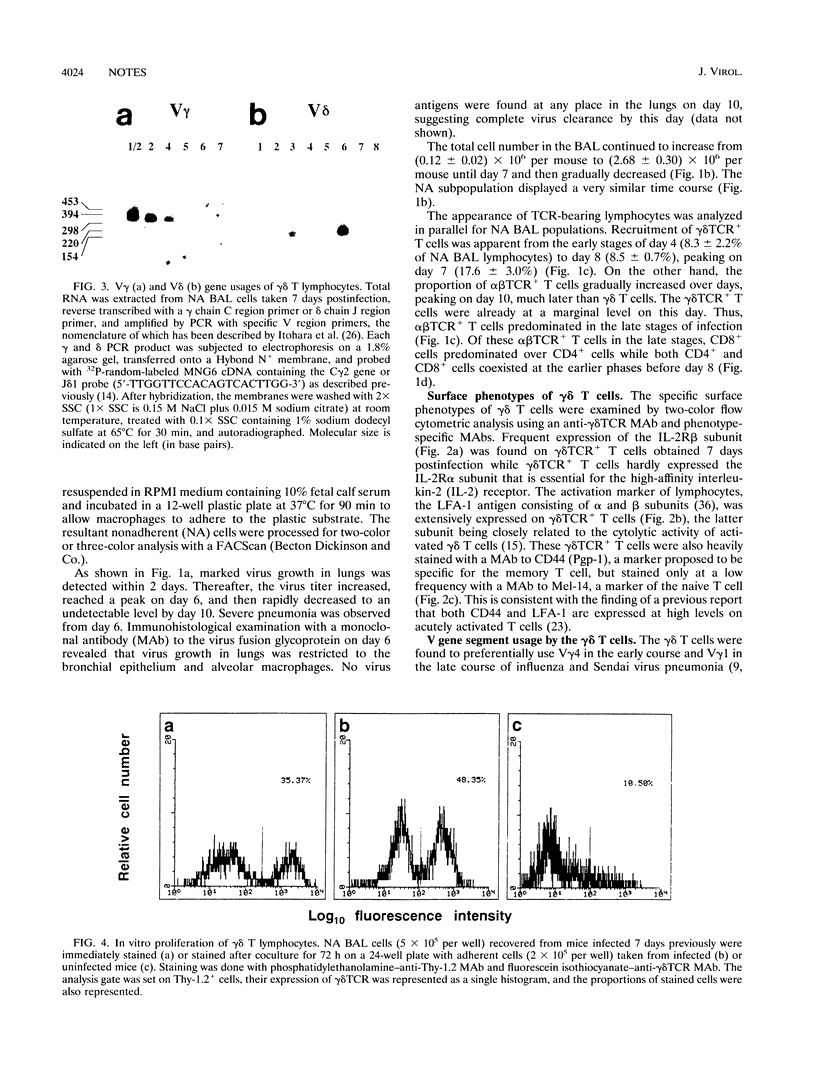
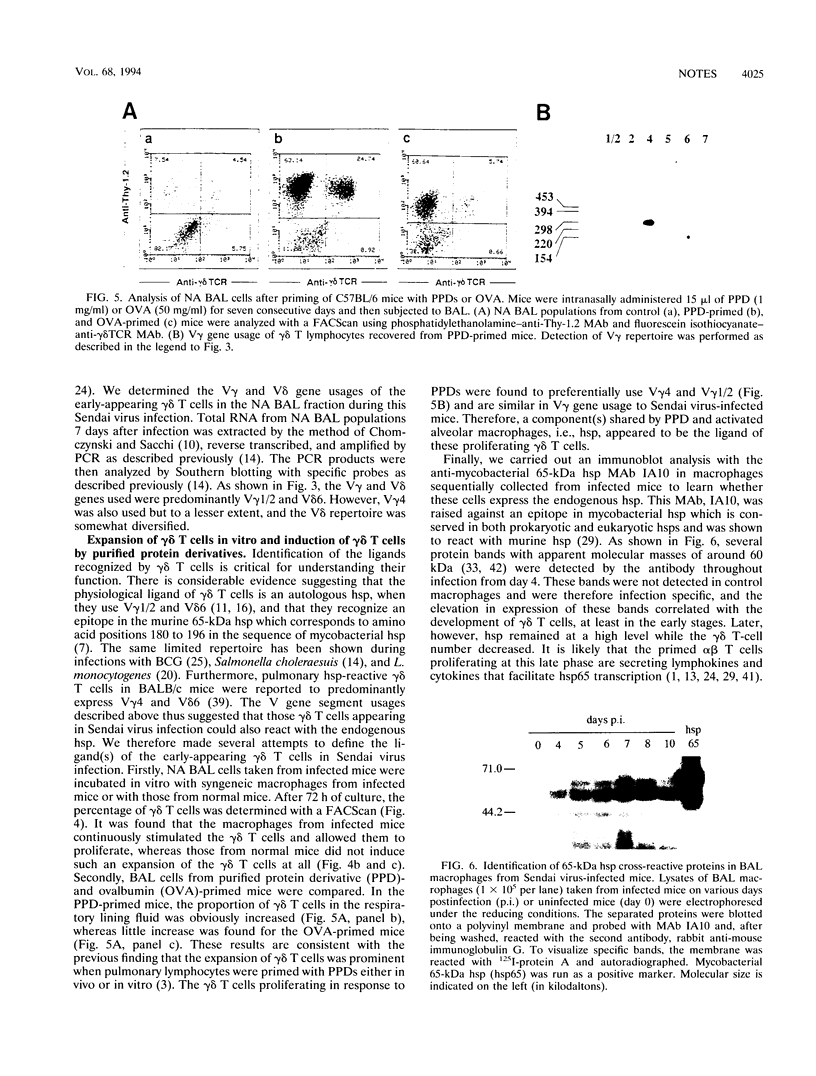

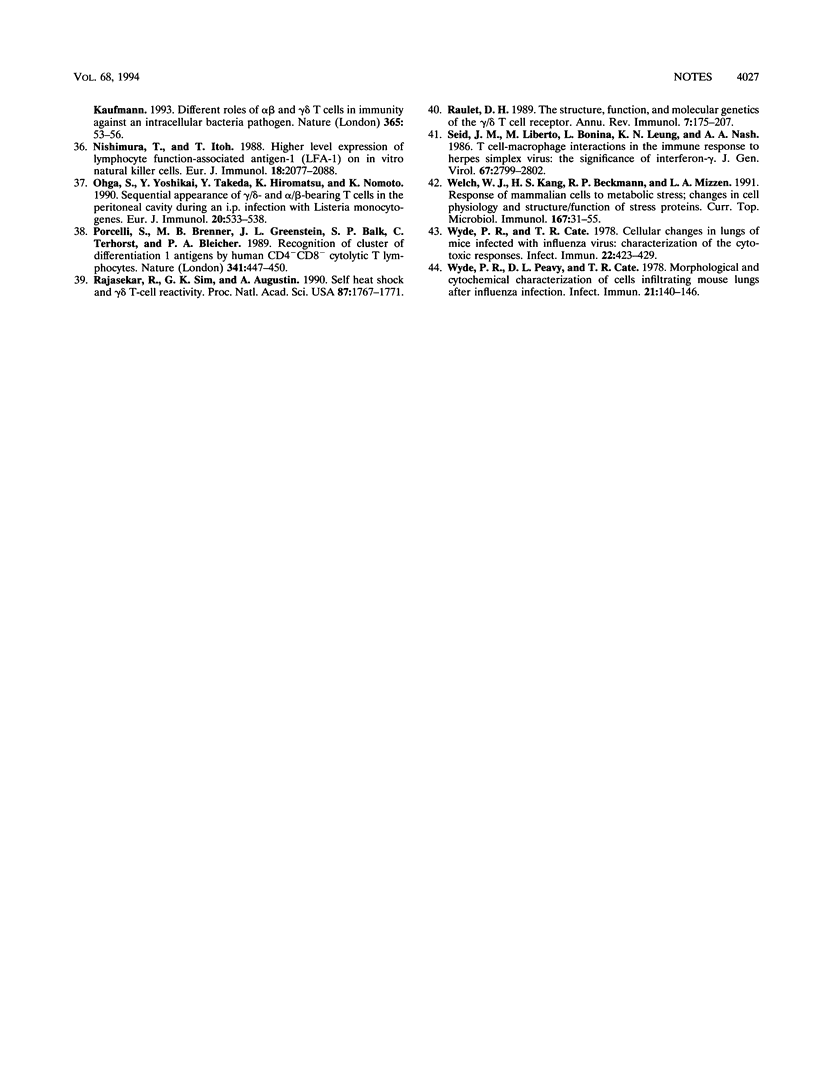
Images in this article
Selected References
These references are in PubMed. This may not be the complete list of references from this article.
- Allan W., Carding S. R., Eichelberger M., Doherty P. C. hsp65 mRNA+ macrophages and gamma delta T cells in influenza virus-infected mice depleted of the CD4+ and CD8+ lymphocyte subsets. Microb Pathog. 1993 Jan;14(1):75–84. doi: 10.1006/mpat.1993.1008. [DOI] [PubMed] [Google Scholar]
- Appleyard G., Davis G. B. Activation of Sendai virus infectivity by an enzyme in chicken amniotic fluid. J Gen Virol. 1983 Apr;64(Pt 4):813–823. doi: 10.1099/0022-1317-64-4-813. [DOI] [PubMed] [Google Scholar]
- Augustin A., Kubo R. T., Sim G. K. Resident pulmonary lymphocytes expressing the gamma/delta T-cell receptor. Nature. 1989 Jul 20;340(6230):239–241. doi: 10.1038/340239a0. [DOI] [PubMed] [Google Scholar]
- Autran B., Triebel F., Katlama C., Rozenbaum W., Hercend T., Debre P. T cell receptor gamma/delta+ lymphocyte subsets during HIV infection. Clin Exp Immunol. 1989 Feb;75(2):206–210. [PMC free article] [PubMed] [Google Scholar]
- Bluestone J. A., Cron R. Q., Cotterman M., Houlden B. A., Matis L. A. Structure and specificity of T cell receptor gamma/delta on major histocompatibility complex antigen-specific CD3+, CD4-, CD8- T lymphocytes. J Exp Med. 1988 Nov 1;168(5):1899–1916. doi: 10.1084/jem.168.5.1899. [DOI] [PMC free article] [PubMed] [Google Scholar]
- Bonneville M., Ito K., Krecko E. G., Itohara S., Kappes D., Ishida I., Kanagawa O., Janeway C. A., Murphy D. B., Tonegawa S. Recognition of a self major histocompatibility complex TL region product by gamma delta T-cell receptors. Proc Natl Acad Sci U S A. 1989 Aug;86(15):5928–5932. doi: 10.1073/pnas.86.15.5928. [DOI] [PMC free article] [PubMed] [Google Scholar]
- Born W., Hall L., Dallas A., Boymel J., Shinnick T., Young D., Brennan P., O'Brien R. Recognition of a peptide antigen by heat shock--reactive gamma delta T lymphocytes. Science. 1990 Jul 6;249(4964):67–69. doi: 10.1126/science.1695022. [DOI] [PubMed] [Google Scholar]
- Brenner M. B., Strominger J. L., Krangel M. S. The gamma delta T cell receptor. Adv Immunol. 1988;43:133–192. [PubMed] [Google Scholar]
- Carding S. R., Allan W., Kyes S., Hayday A., Bottomly K., Doherty P. C. Late dominance of the inflammatory process in murine influenza by gamma/delta + T cells. J Exp Med. 1990 Oct 1;172(4):1225–1231. doi: 10.1084/jem.172.4.1225. [DOI] [PMC free article] [PubMed] [Google Scholar]
- Chomczynski P., Sacchi N. Single-step method of RNA isolation by acid guanidinium thiocyanate-phenol-chloroform extraction. Anal Biochem. 1987 Apr;162(1):156–159. doi: 10.1006/abio.1987.9999. [DOI] [PubMed] [Google Scholar]
- Cron R. Q., Gajewski T. F., Sharrow S. O., Fitch F. W., Matis L. A., Bluestone J. A. Phenotypic and functional analysis of murine CD3+,CD4-,CD8- TCR-gamma delta-expressing peripheral T cells. J Immunol. 1989 Jun 1;142(11):3754–3762. [PubMed] [Google Scholar]
- De Paoli P., Gennari D., Martelli P., Cavarzerani V., Comoretto R., Santini G. Gamma delta T cell receptor-bearing lymphocytes during Epstein-Barr virus infection. J Infect Dis. 1990 May;161(5):1013–1016. doi: 10.1093/infdis/161.5.1013. [DOI] [PubMed] [Google Scholar]
- Doherty P. C., Allan W., Eichelberger M., Carding S. R. Heat-shock proteins and the gamma delta T cell response in virus infections: implications for autoimmunity. Springer Semin Immunopathol. 1991;13(1):11–24. doi: 10.1007/BF01225275. [DOI] [PubMed] [Google Scholar]
- Emoto M., Danbara H., Yoshikai Y. Induction of gamma/delta T cells in murine salmonellosis by an avirulent but not by a virulent strain of Salmonella choleraesuis. J Exp Med. 1992 Aug 1;176(2):363–372. doi: 10.1084/jem.176.2.363. [DOI] [PMC free article] [PubMed] [Google Scholar]
- Ensslin A. S., Formby B. Comparison of cytolytic and proliferative activities of human gamma delta and alpha beta T cells from peripheral blood against various human tumor cell lines. J Natl Cancer Inst. 1991 Nov 6;83(21):1564–1569. doi: 10.1093/jnci/83.21.1564. [DOI] [PubMed] [Google Scholar]
- Happ M. P., Kubo R. T., Palmer E., Born W. K., O'Brien R. L. Limited receptor repertoire in a mycobacteria-reactive subset of gamma delta T lymphocytes. Nature. 1989 Dec 7;342(6250):696–698. doi: 10.1038/342696a0. [DOI] [PubMed] [Google Scholar]
- Hara T., Mizuno Y., Takaki K., Takada H., Akeda H., Aoki T., Nagata M., Ueda K., Matsuzaki G., Yoshikai Y. Predominant activation and expansion of V gamma 9-bearing gamma delta T cells in vivo as well as in vitro in Salmonella infection. J Clin Invest. 1992 Jul;90(1):204–210. doi: 10.1172/JCI115837. [DOI] [PMC free article] [PubMed] [Google Scholar]
- Hasegawa T., Tanaka T., Yoshikai Y. The appearance and role of gamma delta T cells in the peritoneal cavity and liver during primary infection with Listeria monocytogenes in rats. Int Immunol. 1992 Oct;4(10):1129–1136. doi: 10.1093/intimm/4.10.1129. [DOI] [PubMed] [Google Scholar]
- Heilig J. S., Tonegawa S. Diversity of murine gamma genes and expression in fetal and adult T lymphocytes. 1986 Aug 28-Sep 3Nature. 322(6082):836–840. doi: 10.1038/322836a0. [DOI] [PubMed] [Google Scholar]
- Hiromatsu K., Yoshikai Y., Matsuzaki G., Ohga S., Muramori K., Matsumoto K., Bluestone J. A., Nomoto K. A protective role of gamma/delta T cells in primary infection with Listeria monocytogenes in mice. J Exp Med. 1992 Jan 1;175(1):49–56. doi: 10.1084/jem.175.1.49. [DOI] [PMC free article] [PubMed] [Google Scholar]
- Ho M., Webster H. K., Tongtawe P., Pattanapanyasat K., Weidanz W. P. Increased gamma delta T cells in acute Plasmodium falciparum malaria. Immunol Lett. 1990 Aug;25(1-3):139–141. doi: 10.1016/0165-2478(90)90105-y. [DOI] [PubMed] [Google Scholar]
- Holoshitz J., Koning F., Coligan J. E., De Bruyn J., Strober S. Isolation of CD4- CD8- mycobacteria-reactive T lymphocyte clones from rheumatoid arthritis synovial fluid. Nature. 1989 May 18;339(6221):226–229. doi: 10.1038/339226a0. [DOI] [PubMed] [Google Scholar]
- Hou S., Doherty P. C. Partitioning of responder CD8+ T cells in lymph node and lung of mice with Sendai virus pneumonia by LECAM-1 and CD45RB phenotype. J Immunol. 1993 Jun 15;150(12):5494–5500. [PubMed] [Google Scholar]
- Hou S., Katz J. M., Doherty P. C., Carding S. R. Extent of gamma delta T cell involvement in the pneumonia caused by Sendai virus. Cell Immunol. 1992 Aug;143(1):183–193. doi: 10.1016/0008-8749(92)90015-h. [DOI] [PubMed] [Google Scholar]
- Inoue T., Yoshikai Y., Matsuzaki G., Nomoto K. Early appearing gamma/delta-bearing T cells during infection with Calmétte Guérin bacillus. J Immunol. 1991 Apr 15;146(8):2754–2762. [PubMed] [Google Scholar]
- Itohara S., Farr A. G., Lafaille J. J., Bonneville M., Takagaki Y., Haas W., Tonegawa S. Homing of a gamma delta thymocyte subset with homogeneous T-cell receptors to mucosal epithelia. Nature. 1990 Feb 22;343(6260):754–757. doi: 10.1038/343754a0. [DOI] [PubMed] [Google Scholar]
- Janis E. M., Kaufmann S. H., Schwartz R. H., Pardoll D. M. Activation of gamma delta T cells in the primary immune response to Mycobacterium tuberculosis. Science. 1989 May 12;244(4905):713–716. doi: 10.1126/science.2524098. [DOI] [PubMed] [Google Scholar]
- Kawabe T., Isobe K. I., Hasegawa Y., Nakashima I., Shimokata K. Immunosuppressive activity induced by nitric oxide in culture supernatant of activated rat alveolar macrophages. Immunology. 1992 May;76(1):72–78. [PMC free article] [PubMed] [Google Scholar]
- Koga T., Wand-Württenberger A., DeBruyn J., Munk M. E., Schoel B., Kaufmann S. H. T cells against a bacterial heat shock protein recognize stressed macrophages. Science. 1989 Sep 8;245(4922):1112–1115. doi: 10.1126/science.2788923. [DOI] [PubMed] [Google Scholar]
- Matis L. A., Cron R., Bluestone J. A. Major histocompatibility complex-linked specificity of gamma delta receptor-bearing T lymphocytes. Nature. 1987 Nov 19;330(6145):262–264. doi: 10.1038/330262a0. [DOI] [PubMed] [Google Scholar]
- Matis L. A., Fry A. M., Cron R. Q., Cotterman M. M., Dick R. F., Bluestone J. A. Structure and specificity of a class II MHC alloreactive gamma delta T cell receptor heterodimer. Science. 1989 Aug 18;245(4919):746–749. doi: 10.1126/science.2528206. [DOI] [PubMed] [Google Scholar]
- McGarry T. J., Lindquist S. The preferential translation of Drosophila hsp70 mRNA requires sequences in the untranslated leader. Cell. 1985 Oct;42(3):903–911. doi: 10.1016/0092-8674(85)90286-7. [DOI] [PubMed] [Google Scholar]
- Modlin R. L., Pirmez C., Hofman F. M., Torigian V., Uyemura K., Rea T. H., Bloom B. R., Brenner M. B. Lymphocytes bearing antigen-specific gamma delta T-cell receptors accumulate in human infectious disease lesions. Nature. 1989 Jun 15;339(6225):544–548. doi: 10.1038/339544a0. [DOI] [PubMed] [Google Scholar]
- Mombaerts P., Arnoldi J., Russ F., Tonegawa S., Kaufmann S. H. Different roles of alpha beta and gamma delta T cells in immunity against an intracellular bacterial pathogen. Nature. 1993 Sep 2;365(6441):53–56. doi: 10.1038/365053a0. [DOI] [PubMed] [Google Scholar]
- Nishimura T., Itoh T. Higher level expression of lymphocyte function-associated antigen-1 (LFA-1) on in vivo natural killer cells. Eur J Immunol. 1988 Dec;18(12):2077–2080. doi: 10.1002/eji.1830181231. [DOI] [PubMed] [Google Scholar]
- Ohga S., Yoshikai Y., Takeda Y., Hiromatsu K., Nomoto K. Sequential appearance of gamma/delta- and alpha/beta-bearing T cells in the peritoneal cavity during an i.p. infection with Listeria monocytogenes. Eur J Immunol. 1990 Mar;20(3):533–538. doi: 10.1002/eji.1830200311. [DOI] [PubMed] [Google Scholar]
- Porcelli S., Brenner M. B., Greenstein J. L., Balk S. P., Terhorst C., Bleicher P. A. Recognition of cluster of differentiation 1 antigens by human CD4-CD8-cytolytic T lymphocytes. Nature. 1989 Oct 5;341(6241):447–450. doi: 10.1038/341447a0. [DOI] [PubMed] [Google Scholar]
- Rajasekar R., Sim G. K., Augustin A. Self heat shock and gamma delta T-cell reactivity. Proc Natl Acad Sci U S A. 1990 Mar;87(5):1767–1771. doi: 10.1073/pnas.87.5.1767. [DOI] [PMC free article] [PubMed] [Google Scholar]
- Raulet D. H. The structure, function, and molecular genetics of the gamma/delta T cell receptor. Annu Rev Immunol. 1989;7:175–207. doi: 10.1146/annurev.iy.07.040189.001135. [DOI] [PubMed] [Google Scholar]
- Seid J. M., Liberto M., Bonina L., Leung K. N., Nash A. A. T cell-macrophage interactions in the immune response to herpes simplex virus: the significance of interferon-gamma. J Gen Virol. 1986 Dec;67(Pt 12):2799–2802. doi: 10.1099/0022-1317-67-12-2799. [DOI] [PubMed] [Google Scholar]
- Welch W. J., Kang H. S., Beckmann R. P., Mizzen L. A. Response of mammalian cells to metabolic stress; changes in cell physiology and structure/function of stress proteins. Curr Top Microbiol Immunol. 1991;167:31–55. doi: 10.1007/978-3-642-75875-1_2. [DOI] [PubMed] [Google Scholar]
- Wyde P. R., Cate T. R. Cellular changes in lungs of mice infected with influenza virus: characterization of the cytotoxic responses. Infect Immun. 1978 Nov;22(2):423–429. doi: 10.1128/iai.22.2.423-429.1978. [DOI] [PMC free article] [PubMed] [Google Scholar]
- Wyde P. R., Peavy D. L., Cate T. R. Morphological and cytochemical characterization of cells infiltrating mouse lungs after influenza infection. Infect Immun. 1978 Jul;21(1):140–146. doi: 10.1128/iai.21.1.140-146.1978. [DOI] [PMC free article] [PubMed] [Google Scholar]





